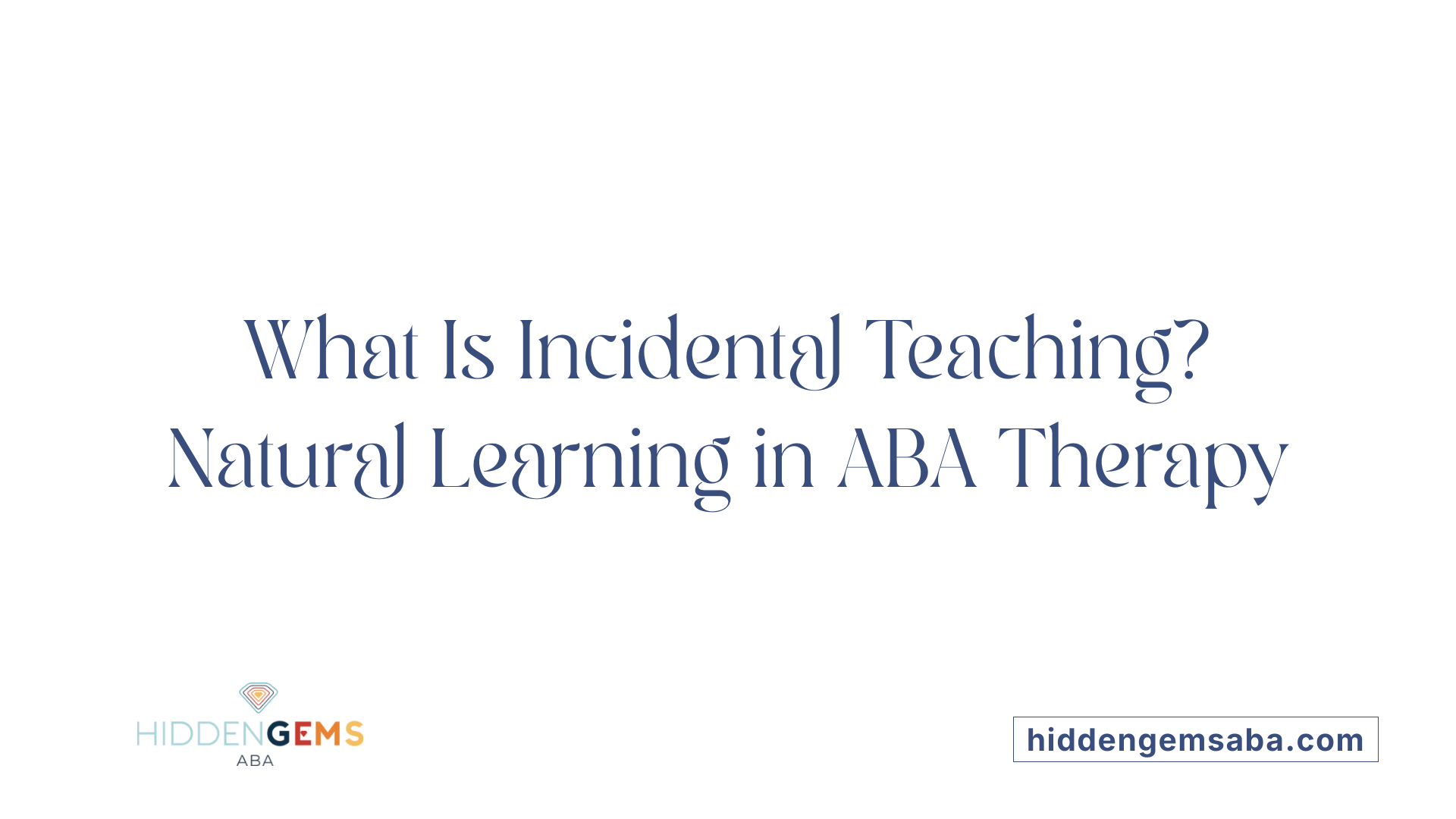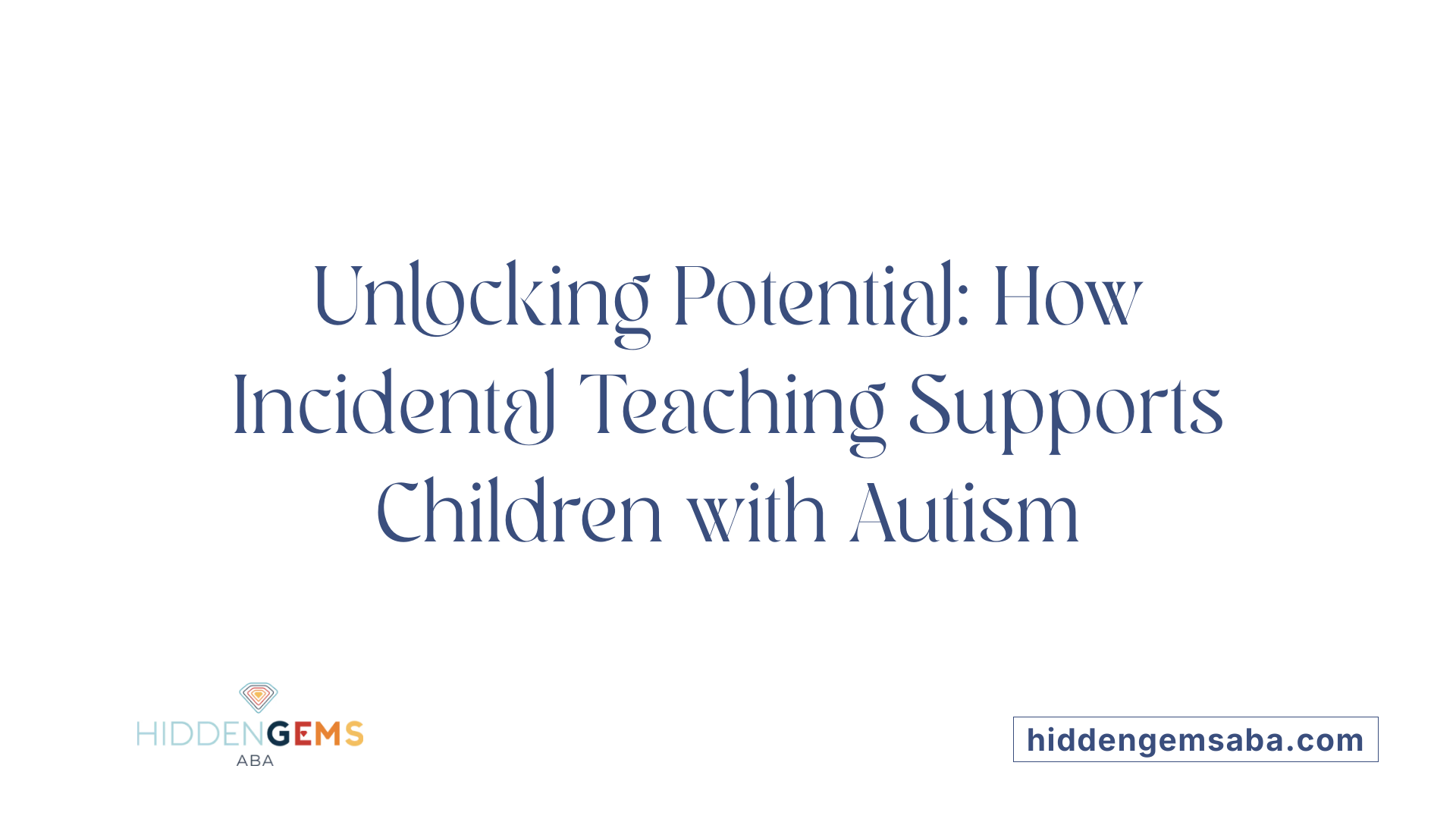Understanding Incidental Teaching in ABA
Incidental teaching stands out as a fundamental naturalistic teaching method within Applied Behavior Analysis (ABA) therapy, offering a highly engaging and effective approach for promoting language, social, and cognitive skills in children with autism. Rooted in natural interactions and routine activities, it fosters authentic learning experiences that are seamlessly integrated into daily life.
What Is Incidental Teaching Within ABA Therapy?

Definition of incidental teaching
Incidental teaching is a teaching method embedded within Applied Behavior Analysis (ABA) therapy that uses everyday situations as natural learning opportunities. Instead of structured, controlled lessons, it relies on the child's spontaneous interests and interactions occurring in routine environments. The main goal is to promote language, social, and behavioral skills by encouraging children to lead their learning experiences.
Therapists observe children during regular activities, wait for them to initiate communication or a desired behavior, and then provide prompts, reinforcement, or modeling to foster skill development. This approach makes learning engaging and meaningful, helping children apply skills across different settings.
Historical background and origins
Incidental teaching came into focus in the 1970s, with foundational work by Hart and Risley, who highlighted naturalistic methods for promoting language development. Over the years, research supports its effectiveness, with scholarly articles appearing from the early 1990s through recent years, emphasizing its role in enhancing spontaneous speech, social responses, and generalization abilities.
Initially developed for children with autism, incidental teaching has expanded to include individuals with various developmental delays and learning disorders. Its longstanding history underscores its importance in the field of behavior analysis.
Principles of naturalistic teaching
The approach aligns with core ABA principles—individualized instruction and reinforcement—by creating motivating environments based on the child's interests. It involves following the child's lead, engaging them in meaningful activities, and reinforcing responses with natural consequences.
Key principles include:
- Utilizing familiar routines and interests
- Allowing the child to initiate interactions
- Providing prompts and fading support gradually
- Using natural reinforcers like praise or access to preferred items
By leveraging these principles, incidental teaching fosters authentic learning experiences that promote communication, social skills, and cognitive development, resulting in skills that generalize well beyond therapy sessions.
Implementation of Incidental Teaching in ABA

How is incidental teaching implemented in ABA therapy?
Incidental teaching is carried out by weaving learning opportunities into everyday situations and common routines. For example, a therapist or parent might observe when a child shows interest in a toy or a book, then gently encourage the child to communicate or perform a skill related to that object or activity.
The approach emphasizes following the child's lead by paying close attention to their current interests and activities. When the child initiates interaction, such as reaching for a toy or looking at a picture, the adult responds by prompting or guiding the child to use language or do a specific behavior. Reinforcement, like praise or access to the object, is given to encourage repeated use of the skill.
Gradually, prompts are faded so the child can perform the skill independently. This naturalistic method helps children learn in context and transfer their skills across different settings, making their progress more meaningful and spontaneous.
Use of natural routines and interests
The success of incidental teaching hinges on integrating learning into child's natural routines and interests. Routine activities like mealtime, playtime, or dressing provide perfect opportunities for teaching.
By aligning lessons with what the child already enjoys or is curious about, interest and motivation are boosted. For example, if a child shows interest in stacking blocks, a therapist may encourage naming the blocks or requesting more during that activity.
Role of prompts and reinforcement
Prompts are used to guide the child's responses when necessary, with the intention of fading them over time to foster independence. Reinforcement involves positive feedback, praise, or access to preferred items that motivate the child. For example, if a child correctly labels an object, they might receive verbal praise or access to a toy. These supports encourage continued skill use and help solidify learning.
Involving caregivers and educators
Involving parents, caregivers, and educators is crucial for consistency. They are trained to recognize natural opportunities, prompt effectively, and reinforce skills. This collaborative effort ensures that skills learned during therapy are practiced across different environments, promoting generalization and long-term progress.
| Step | Action | Details |
|---|---|---|
| 1 | Create an engaging environment | Use familiar routines and interests to set the stage for learning. |
| 2 | Observe natural interests | Watch for when the child shows curiosity or initiates activity. |
| 3 | Prompt responses | Use gentle prompts aligned with natural cues. |
| 4 | Reinforce appropriately | Offer praise or access to preferred items in response to desired behavior. |
| 5 | Fade prompts | Gradually reduce prompts to promote independence. |
| 6 | Involve caregivers | Train and encourage consistent practice outside therapy sessions. |
This approach makes learning an intrinsic part of daily life, helping children develop vital skills in a context that feels natural and motivating.
Benefits of Incidental Teaching for Children with Autism

How does incidental teaching promote language development?
Incidental teaching significantly boosts language skills by embedding vocabulary learning within natural interactions. During everyday activities and play, children are encouraged to label objects, describe actions, and express their interests. The approach focuses on spontaneous, meaningful communication, fostering the child's ability to articulate needs and thoughts.
How does incidental teaching enhance social interaction?
This method nurtures social skills by providing real-time opportunities for children to initiate conversations and respond to others. When children show interest in activities, therapists or parents guide them to interact more, promoting turn-taking, sharing, and peer interactions. The naturalistic setting reduces pressure, making social exchanges more engaging and less intimidating.
How does incidental teaching promote independence and skill generalization?
By integrating learning into familiar routines and daily environments, children learn to apply skills across various contexts. When skills are practiced in natural settings like at home or during outdoor play, they become more robust and transferable. This encourages independence, as children become confident in using communication and behavioral skills beyond therapy sessions.
In what ways does the use of natural environments benefit children?
Applying incidental teaching in natural environments makes learning more relevant and motivating. It leverages the child's interests and spontaneous curiosity, which increases motivation and participation. Caregivers and educators can seamlessly incorporate teaching moments into daily life, ensuring consistent reinforcement and maximizing learning opportunities.
| Aspect | How It Helps | Additional Details |
|---|---|---|
| Language Development | Builds vocabulary and expressive skills | Through labeling, describing, and requesting during play |
| Social Interaction | Improves peer and adult communication | Via spontaneous exchanges and shared activities |
| Independence | Fosters self-sufficient use of skills | By practicing in familiar, everyday settings |
| Natural Environment | Enhances motivation and learning | Includes routines and interests tailored to the child |
Overall, incidental teaching aligns with ABA principles by customizing learning to each child's natural environment, making skill acquisition meaningful and sustainable. Its success relies on understanding the child's interests, providing appropriate reinforcement, and involving caregivers for consistency.
Role of Incidental Teaching in Language Development for Preschoolers with Autism
What role does incidental teaching play in language development for preschoolers with autism?
Incidental teaching is a highly effective approach used in ABA therapy to support language growth in preschoolers with autism. This naturalistic method creates learning opportunities within everyday environments by leveraging the child’s interests and motivations. Rather than structured drills, it encourages children to initiate interactions and express themselves spontaneously.
The process involves arranging natural settings so that children are motivated to communicate. For example, during play or daily routines, therapists and caregivers subtly prompt and reinforce the child's attempts at labeling, describing, or requesting. This fosters active participation and promotes the use of language in meaningful contexts.
One of the main strengths of incidental teaching is its focus on generalization. Skills acquired during these naturally occurring interactions are more likely to transfer to other settings, such as home, school, or community. This is because the teaching takes place in familiar environments where children feel comfortable and interested.
In applying incidental teaching, professionals use ABA principles like positive reinforcement, prompting, modeling, and fading to reinforce communication efforts. They may control access to desired items, encourage the child to lead the interaction, and provide timely praise or other rewards.
Research shows that incidental teaching significantly boosts vocabulary, conversational skills, and social engagement among children with autism. It helps children become more autonomous communicators and enhances their ability to interact effectively with peers, parents, and teachers.
By integrating language learning into daily activities, incidental teaching makes learning more engaging and relevant. It supports children in developing skills that are essential for successful socialization and learning beyond the therapy setting.
Research and Efficacy of Incidental Teaching

What is the research evidence regarding the effectiveness of incidental teaching in ABA?
Incidental teaching has been studied extensively, with research showing it as an effective naturalistic approach within ABA therapy. Evidence indicates that this method can significantly enhance language, social, and adaptive skills in children, particularly those with autism. Early studies, dating back nearly 50 years, laid the groundwork by demonstrating how spontaneous speech and communication can improve when learning is embedded in natural interactions.
Contemporary research continues to support incidental teaching's benefits across various settings and age groups, focusing on its ability to promote generalization and authentic skill development. For example, studies have observed increases in the spontaneous use of complex language structures like compound sentences during natural play and interaction.
Training professionals in proper implementation—such as creating motivating environments, prompting appropriately, and reinforcing naturally occurring behaviors—is also a focus of current research. Results consistently show that high-quality execution is essential for maximizing outcomes.
However, despite its promising results, researchers acknowledge the need for more detailed frameworks and standardized protocols. This will help practitioners apply incidental teaching consistently and effectively, especially within early intervention for autism.
In summary, the existing evidence underscores incidental teaching as a valuable tool in ABA, with ongoing research aimed at optimizing its methods and expanding its application.
| Study Focus | Findings | Next Steps |
|---|---|---|
| Language Development | Increase in spontaneous speech and compound sentences | Develop standardized procedures |
| Social Skills | Improved peer interactions | Broaden age range and settings |
| Implementation | Effect of training providers | Optimize training programs |
| Long-Term Outcomes | Robust generalization of skills | Conduct longitudinal studies |
This ongoing research continues to shape the future use of incidental teaching, ensuring it remains a vital component of behavioral intervention strategies.
Core Principles and Applications of Incidental Teaching in ABA

Following the child's lead
Incidental teaching centers on allowing children to direct the interaction. Therapists or caregivers observe what interests the child and wait for moments when they naturally initiate communication or play. By following the child's cues, the approach creates a comfortable environment where learning feels like a natural extension of their curiosity and activities.
Natural reinforcement
In this method, the stimuli and rewards used are part of the child's daily environment. Instead of contrived tokens or artificial rewards, children are motivated by items and activities they already enjoy. This natural reinforcement makes learning more appealing and meaningful, promoting sustained engagement.
Embedding in daily routines
Incidental teaching is integrated seamlessly into everyday activities such as mealtime, play, or chores. These routines provide abundant opportunities for skill development without needing special setups. For example, a child describing their sandwich or asking for a toy during play can be used as moments for targeted teaching.
Promoting generalization and motivation
By teaching in natural settings and using objects and activities familiar to the child, incidental teaching encourages the transfer of skills across different environments and people. Children tend to be more motivated because learning occurs during their preferred activities, making it more likely they will apply their new skills spontaneously in real-life situations.
Application in practice
Implementation involves creating an engaging environment, initiating prompts with natural cues, and gradually fading assistance as the child gains independence. Caregivers, teachers, speech pathologists, and occupational therapists collaborate to maintain consistency across settings. This teamwork ensures that the child's progress is continuous and well-supported.
Research and long-term impact
Studies show that incidental teaching substantially improves spontaneous language use, social interactions, and cognitive skills. Its long-standing use over decades highlights its effectiveness as a naturalistic, child-centered approach.
| Aspect | Description | Typical Settings | Involved Professionals |
|---|---|---|---|
| Following the child's lead | Child-initiated interactions guide teaching | Home, school, therapy sessions | Parents, therapists, teachers |
| Natural reinforcement | Rewards are part of daily life | Play, routines, outings | Multidisciplinary team |
| Embedding in routines | Incorporates learning into daily activities | Mealtimes, play, chores | Caregivers, specialists |
| Promoting generalization | Skills transfer across settings | Multiple environments | All team members |
Overall, incidental teaching offers a flexible, engaging way to foster meaningful learning experiences that align with a child's natural interests and daily life, building foundation skills that last.
Moving Forward with Naturalistic ABA
Incidental teaching stands as a powerful, evidence-based approach within the realm of ABA therapy. Its emphasis on natural environments, child-led interactions, and functional skill development makes it highly effective in fostering meaningful improvements in language, social skills, and adaptive behaviors among children with autism. Continued research, combined with collaborative efforts among therapists, parents, and educators, can further enhance its application and outcomes. By embracing the core principles of incidental teaching, practitioners can create enriching, motivating environments that not only promote skill acquisition but also support long-term generalization and independence for children across diverse settings.






